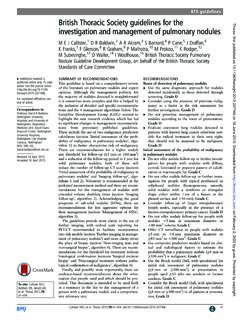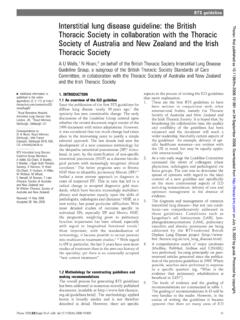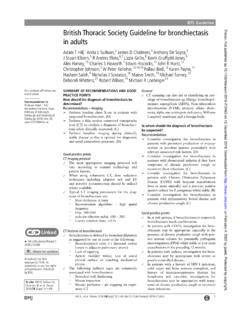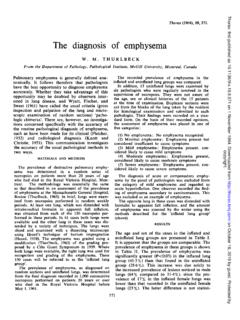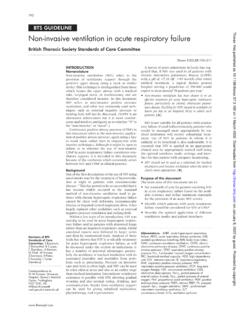Transcription of BTS/ICS guideline for the ventilatory management of acute ...
1 BTS/ICS guideline for the ventilatory managementof acute hypercapnic respiratory failure in adultsACraigDavidson,1 Stephen Banham,1 Mark Elliott,2 Daniel Kennedy,3 Colin Gelder,4 Alastair Glossop,5 Alistair Colin Church,6 Ben Creagh-Brown,7 James William Dodd,8,9 Tim Felton,10 Bernard Fo x,11 Leigh Mansfield,12 Lynn McDonnell,13 Robert Parker,14 Caroline Marie Patterson,15 Milind Sovani,16 Lynn Thomas,17 BTS Standards ofCare Committee Member, British Thoracic Society/Intensive Care Society AcuteHypercapnic respiratory failure guideline Development Group, On behalf of theBritish Thoracic Society Standards of Care Committee Additional material ispublished online only.
2 To viewplease visit the journal online( ).For numbered affiliations seeend of toDr A C Davidson,BTS, 17 Doughty Street,London WC1N 2PL, providers need touse clinical judgement,knowledge and expertise whendeciding whether it isappropriate to applyrecommendations for themanagement of patients. Therecommendations cited hereare a guide and may not beappropriate for use in allsituations. The guidanceprovided does not override theresponsibility of healthcareprofessionals to make decisionsappropriate to thecircumstances of each patient,in consultation with the patientand/or their guardian or 17 December 2015 Accepted 10 January 2016 cite:Davidson AC,Banham S, Elliott M,et ;71:ii1 OF RECOMMENDATIONSP rinciples of mechanical ventilationModes of mechanical ventilationRecommendation1.
3 Pressure-targeted ventilators are the devices ofchoice for acute NIV (Grade B).Good practice points Both pressure support (PS) and pressure controlmodes are effective. Only ventilators designed specifically to deliverNIV should be of interface for NIVR ecommendation2. A full face mask (FFM) should usually be thefirst type of interface used (Grade D).Good practice points A range of masks and sizes is required and staffinvolved in delivering NIV need training in andexperience of using them. NIV circuits must allow adequate clearance ofexhaled air through an exhalation valve or anintegral exhalation port on the for and contra-indications to NIV inAHRFR ecommendation3.
4 The presence of adverse features increase therisk of NIV failure and should prompt consider-ation of placement in high dependency unit(HDU)/intensive care unit (ICU) (Grade C).Good practice points Adverse features should not, on their own, leadto withholding a trial of NIV. The presence of relative contra-indicationsnecessitates a higher level of supervision, consid-eration of placement in HDU/ICU and an earlyappraisal of whether to continue NIV or toconvert to invasive mechanical ventilation(IMV).Monitoring during NIVGood practice points Oxygen saturation should be continuouslymonitored.
5 Intermittent measurement of pCO2and pH isrequired. ECG monitoring is advised if the patient has apulse rate >120 bpm or if there is dysrhythmiaor possible oxygen therapy with NIVR ecommendations4. Oxygen enrichment should be adjusted toachieve SaO288 92% in all causes of acute hyper-capnic respiratory failure (AHRF) treated by NIV(Grade A).5. Oxygen should be entrained as close to thepatient as possible (Grade C).Good practice points As gas exchange will improve with increasedalveolar ventilation, NIV settings should be opti-mised before increasing the FiO2. Theflow rate of supplemental oxygen may need tobe increased when ventilatory pressure is increasedto maintain the same SaO2 target.
6 Mask leak and delayed triggering may be causedby oxygenflow rates >4 L/min, which risks pro-moting or exacerbating patient-ventilator asyn-chrony. The requirement for highflow ratesshould prompt a careful check for patient-ventilator asynchrony. A ventilator with an integral oxygen blender isrecommended if oxygen at 4 L/min fails tomaintain SaO2 >88%.Humidification with NIVR ecommendation6. Humidification is not routinely required(Grade D).Good practice pointHeated humidification should be considered if thepatient reports mucosal dryness or if respiratorysecretions are thick and therapy with NIVGood practice points Nebulised drugs should normally be adminis-tered during breaks from NIV.
7 If the patient is dependent on NIV, bronchodila-tor drugs can be given via a nebuliser insertedinto the ventilator AC,et ;71:ii1 ii35. guidelines on March 1, 2022 by guest. Protected by : first published as on 14 March 2016. Downloaded from on March 1, 2022 by guest. Protected by : first published as on 14 March 2016. Downloaded from on March 1, 2022 by guest. Protected by : first published as on 14 March 2016. Downloaded from Sedation with NIVR ecommendations7. Sedation should only be used with close monitoring(Grade D).8. Infused sedative/anxiolytic drugs should only be used in anHDU or ICU setting (Grade D).
8 9. If intubation is not intended should NIV fail, then sedation/anxiolysis is indicated for symptom control in the distressed oragitated patient (Grade D).Good practice pointIn the agitated/distressed and/or tachypnoeic individualonNIV, intravenous morphine 5 mg ( benzodiazepine) mayprovide symptom relief and may improve tolerance of complicationsGood practice points Minor complications are common but those of a seriousnature are rare. Patients should be frequently assessed toidentify potential complications of NIV. Care is needed to avoid overtightening of masks. Previous episodes of ventilator-associated pneumothoraxwarrant consideration of admission to HDU/ICU and use ofNIVat lower than normal inspiratory pressures.
9 The development of a pneumothorax usually requires inter-costal drainage and review of whether to continue with retentionRecommendations10. In patients with neuromuscular disease (NMD), mechanicalinsufflation and exsufflation should be used, in addition tostandard physiotherapy techniques, when cough is ineffectiveand there is sputum retention (Grade B).11. Mini-tracheostomy may have a role in aiding secretion clear-ance in cases of weak cough (NMD/chest wall disease (CWD)) orexcessive amounts (COPD, cysticfibrosis (CF)) (Grade D).Modes of IMVR ecommendations12. Spontaneous breathing should be established as soon as pos-sible in all causes of AHRF (Grade C).
10 13. Controlled IMV may need to be continued in some patientsdue to severe airflow obstruction, weak muscles leading to poortriggering or to correct chronic hypercapnia (Grade C).Good practice pointIn obstructive diseases, controlled IMV should be continueduntil airway resistance ventilation strategyRecommendations14. During controlled ventilation, dynamic hyperinflation should beminimisedbyprolongingexpiratorytime(I: Eratio1:3orgreater)and setting a low frequency (10 15 breaths/min) (Grade C).15. Permissive hypercapnia (aiming for pH ) may berequired to avoid high airway pressures when airflow obstruc-tion is severe (Grade D).


